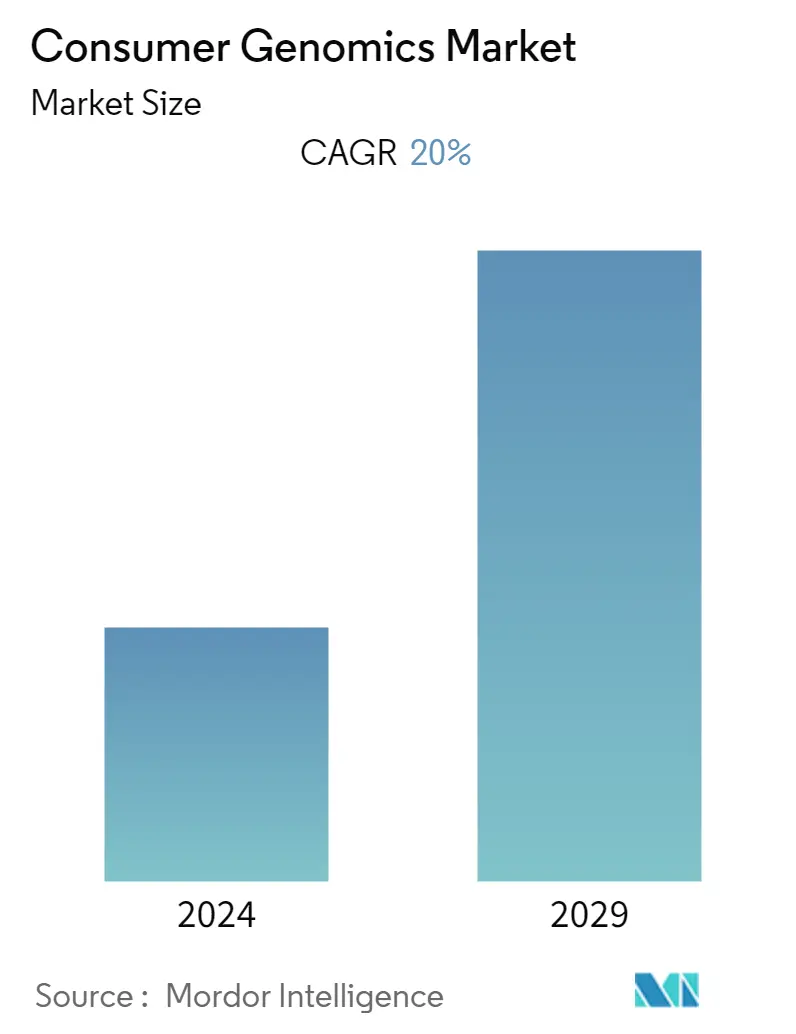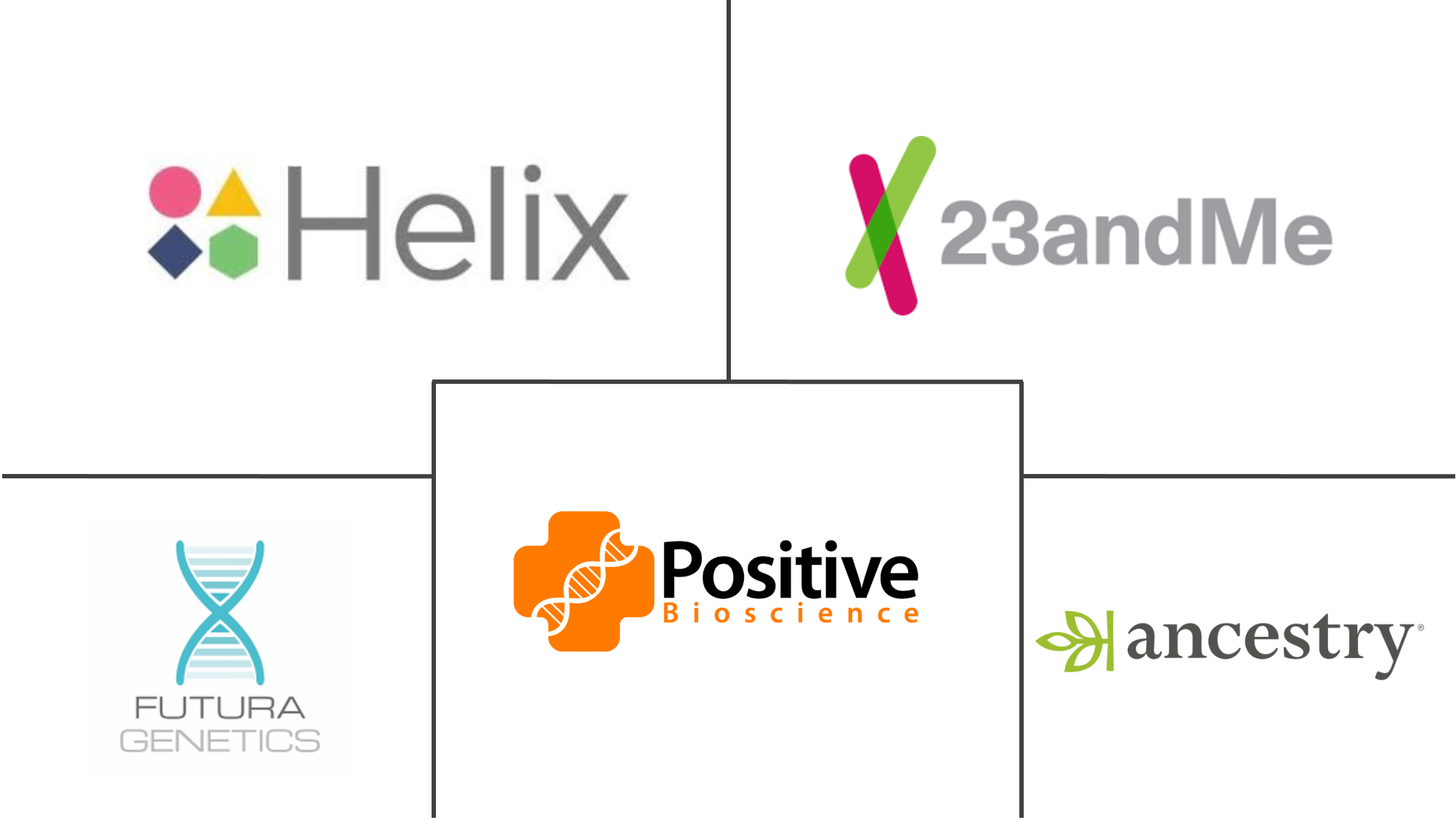Market Size of Consumer Genomics Industry

| Study Period | 2019 - 2029 |
| Base Year For Estimation | 2023 |
| CAGR | 20.00 % |
| Fastest Growing Market | Asia-Pacific |
| Largest Market | North America |
| Market Concentration | Medium |
Major Players
*Disclaimer: Major Players sorted in no particular order |
Consumer Genomics Market Analysis
The consumer genomics market is expected to register a CAGR of 20% during the forecast period.
The market peaked during the COVID-19 pandemic. Consumer genomics was a valuable tool in the characterization and identification of the SARS-CoV-2 virus. It had the potential to determine the genetic sequence of a virus and help scientists understand the mutations. Throughout the pandemic, government authorities worldwide constantly worked with the private sector to bring consumer genomics as a diagnostic tool into the market.
As per the report published by Oxford University Press in March 2021, the COVID-19 pandemic sparked the development and adaptation of several informatics techniques in addition to bioinformatics research. Next-generation sequencing was the central technology for detecting genomes of SARS-CoV-2 that provided the primary data about the virus. These included computational methods for tracing and tracking infected individuals, collaborative data infrastructures for COVID-19 research, sentiment analysis techniques for evaluating the effectiveness of lockdown measures, artificial intelligence techniques, and robotics applications to support remote patient assistance.
Furthermore, post-pandemic, people have become more health-conscious, potentially leading them to use new and advanced techniques, such as consumer genomics. Hence, owing to the increasing DNA-based research and development activities and bioinformatics in developing diagnostic tools or effective therapeutics for COVID-19, the market is likely to continue its significant growth rate during the forecast period.
The major factors fueling the market growth are the rise in interest of consumers and physicians in DTC kits, advancements in technology, increasing applications of consumer genomics, favorable government policies, and the growing trend of personalized genomics. For instance, according to an article published by ScienceDirect, in 2022, direct-to-consumer (DTC) tests gained popularity. This was because consumers could purchase them directly without any test orders from healthcare professionals. Therefore, DTC tests allowed patients to be actively engaged in their health management.
The DTC industry has been booming due to the increasing awareness and desire for rapid and accessible testing by the public. Such increased demand for DTC tests is expected to drive market growth. In September 2021, MedGenome Labs launched a direct-to-consumer category under the brand name Genessense. Under the new category, MedGenome offered genetic screening tests that can be ordered online through the Genessense website or e-commerce platforms. These advantages and initiatives for DTC tests on consumer genomics are expected to drive the market's growth over the forecast period.
The increasing product innovation and collaboration by key players will also support market growth over the forecast period. In July 2022, 1health.io Inc. expanded its testing in both the clinical and direct-to-consumer markets rapidly and securely. It also partnered with Apollo Health Group to bring Apollo's specialized high-performing NGS tests, such as hereditary cancer genetic screenings (CGx) and pharmacogenetics screenings (PGx), to the broader clinical market. Such expansions are also aiding the market growth.
Thus, the abovementioned factors are positively impacting the market growth. However, stringent regulatory challenges and misleading results will create challenges in adopting home-based genetic tests. This is expected to hinder market growth over the forecast period.
Consumer Genomics Industry Segmentation
Consumer genomics is a stream of genomics that involves sequencing, investigation, and interpretation of an individual's genome. It includes consumer DNA data that helps offer vital information related to ancestry, drug response, and disease susceptibility.
The Consumer Genomics Market is Segmented by Application (Genetic Relatedness, Diagnostics, Lifestyle, Wellness, & Nutrition, Ancestry, Personalized Medicine & Pharmacogenetic Testing, Sports Nutrition & Health, and Other Application Types) and Geography (North America, Europe, Asia-Pacific, Middle East and Africa, and South America). The report also covers the estimated market sizes and trends for 17 countries across significant regions globally. The report offers the value in USD million for the above segments.
| By Application | |
| Genetic Relatedness | |
| Diagnostics | |
| Lifestyle, Wellness, & Nutrition | |
| Ancestry | |
| Personalized Medicine & Pharmacogenetic Testing | |
| Sports Nutrition & Health | |
| Other Application Types |
| By Geography | ||||||||
| ||||||||
| ||||||||
| ||||||||
| ||||||||
|
Consumer Genomics Market Size Summary
The consumer genomics market is poised for substantial growth, driven by increasing consumer and physician interest in direct-to-consumer (DTC) genetic testing kits, technological advancements, and the expanding applications of genomics. The market experienced a surge during the COVID-19 pandemic, where it played a crucial role in understanding the virus's genetic makeup and mutations. This period saw the integration of consumer genomics into diagnostic tools, supported by collaborations between government and private sectors. Post-pandemic, the heightened health consciousness among individuals has further fueled the adoption of advanced genomic techniques. The trend towards personalized genomics, supported by favorable government policies and the growing demand for rapid and accessible testing, is expected to sustain the market's robust growth trajectory.
North America is anticipated to lead the consumer genomics market, bolstered by high healthcare expenditure, patient awareness, and the prevalence of target diseases. The region's market growth is further supported by the presence of major players and numerous product launches. The market's competitive landscape is moderately fragmented, with key players like 23andMe, Ancestry, and MyHeritage Ltd. actively participating. Despite the promising growth prospects, challenges such as stringent regulatory hurdles and the potential for misleading results in home-based genetic tests may impede market expansion. Nonetheless, the ongoing innovation and collaboration among industry players, along with the increasing focus on genetic screening for conditions like cancer, are expected to drive the market forward over the forecast period.
Consumer Genomics Market Size - Table of Contents
-
1. MARKET DYNAMICS
-
1.1 Market Overview
-
1.2 Market Drivers
-
1.2.1 Rise in Interest of Consumers & Physicians in DTC kits
-
1.2.2 Advancements in Technology
-
1.2.3 Increasing Applications of Consumer Genomics and Favorable Government Policies
-
1.2.4 Growing Trend of Personalized Genomics
-
-
1.3 Market Restraints
-
1.3.1 Stringent Regulatory Challenges
-
1.3.2 Misleading Results Create Challenges in Adoption of Home-based Genetic Tests
-
-
1.4 Industry Attractiveness - Porter's Five Forces Analysis
-
1.4.1 Threat of New Entrants
-
1.4.2 Bargaining Power of Buyers
-
1.4.3 Bargaining Power of Suppliers
-
1.4.4 Threat of Substitute Products
-
1.4.5 Intensity of Competitive Rivalry
-
-
-
2. MARKET SEGMENTATION (Market Size by Value - USD million)
-
2.1 By Application
-
2.1.1 Genetic Relatedness
-
2.1.2 Diagnostics
-
2.1.3 Lifestyle, Wellness, & Nutrition
-
2.1.4 Ancestry
-
2.1.5 Personalized Medicine & Pharmacogenetic Testing
-
2.1.6 Sports Nutrition & Health
-
2.1.7 Other Application Types
-
-
2.2 By Geography
-
2.2.1 North America
-
2.2.1.1 United States
-
2.2.1.2 Canada
-
2.2.1.3 Mexico
-
-
2.2.2 Europe
-
2.2.2.1 Germany
-
2.2.2.2 United Kingdom
-
2.2.2.3 France
-
2.2.2.4 Italy
-
2.2.2.5 Spain
-
2.2.2.6 Rest of Europe
-
-
2.2.3 Asia-Pacific
-
2.2.3.1 China
-
2.2.3.2 Japan
-
2.2.3.3 India
-
2.2.3.4 Australia
-
2.2.3.5 South Korea
-
2.2.3.6 Rest of Asia-Pacific
-
-
2.2.4 Middle East and Africa
-
2.2.4.1 GCC
-
2.2.4.2 South Africa
-
2.2.4.3 Rest of Middle East and Africa
-
-
2.2.5 South America
-
2.2.5.1 Brazil
-
2.2.5.2 Argentina
-
2.2.5.3 Rest of South America
-
-
-
Consumer Genomics Market Size FAQs
What is the current Consumer Genomics Market size?
The Consumer Genomics Market is projected to register a CAGR of 20% during the forecast period (2024-2029)
Who are the key players in Consumer Genomics Market?
23andMe, Inc., Ancestry, Positive Biosciences, Ltd., Futura Genetics and Helix OpCo LLC are the major companies operating in the Consumer Genomics Market.

